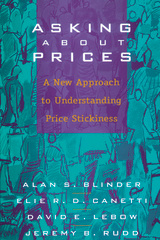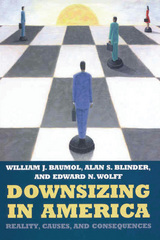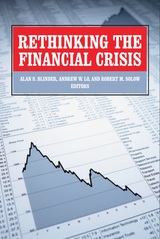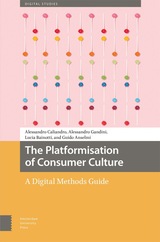3 books by Blinder, Alan

Asking About Prices
A New Approach to Understanding Price Stickiness
Alan Blinder
Russell Sage Foundation, 1998
Why do consumer prices and wages adjust so slowly to changes in market conditions? The rigidity or stickiness of price setting in business is central to Keynesian economic theory and a key to understanding how monetary policy works, yet economists have made little headway in determining why it occurs. Asking About Prices offers a groundbreaking empirical approach to a puzzle for which theories abound but facts are scarce. Leading economist Alan Blinder, along with co-authors Elie Canetti, David Lebow, and Jeremy B. Rudd, interviewed a national, multi-industry sample of 200 CEOs, company heads, and other corporate price setters to test the validity of twelve prominent theories of price stickiness. Using everyday language and pertinent scenarios, the carefully designed survey asked decisionmakers how prominently these theoretical concerns entered into their own attitudes and thought processes. Do businesses tend to view the costs of changing prices as prohibitive? Do they worry that lower prices will be equated with poorer quality goods? Are firms more likely to try alternate strategies to changing prices, such as warehousing excess inventory or improving their quality of service? To what extent are prices held in place by contractual agreements, or by invisible handshakes? Asking About Prices offers a gold mine of previously unavailable information. It affirms the widespread presence of price stickiness in American industry, and offers the only available guide to such business details as what fraction of goods are sold by fixed price contract, how often transactions involve repeat customers, and how and when firms review their prices. Some results are surprising: contrary to popular wisdom, prices do not increase more easily than they decrease, and firms do not appear to practice anticipatory pricing, even when they can foresee cost increases. Asking About Prices also offers a chapter-by-chapter review of the survey findings for each of the twelve theories of price stickiness. The authors determine which theories are most popular with actual price setters, how practices vary within different business sectors, across firms of different sizes, and so on. They also direct economists' attention toward a rationale for price stickiness that does not stem from conventional theory, namely a strong reluctance by firms to antagonize or inconvenience their customers. By illuminating how company executives actually think about price setting, Asking About Prices provides an elegant model of a valuable new approach to conducting economic research.
[more]

Downsizing in America
Reality, Causes, and Consequences
William J. Baumol
Russell Sage Foundation, 2003
In the 1980s and early 1990s, a substantial number of U.S. companies announced major restructuring and downsizing. But we don't know exactly what changes in the U.S. and global economy triggered this phenomenon. Little research has been done on the underlying causes of downsizing. Did companies actually reduce the size of their workforces, or did they simply change the composition of their workforces by firing some kinds of workers and hiring others? Downsizing in America, one of the most comprehensive analyses of the subject to date, confronts all these questions, exploring three main issues: the extent to which firms actually downsized, the factors that triggered changes in firm size, and the consequences of downsizing. The authors show that much of the conventional wisdom regarding the spate of downsizing in the 1980s and 1990s is inaccurate. Nearly half of the large firms that announced major layoffs subsequently increased their workforce by more than 10 percent within two or three years. The only arena in which downsizing predominated appears to be the manufacturing sector-less than 20 percent of the U.S. workforce. Downsizing in America offers a range of compelling hypotheses to account for adoption of downsizing as an accepted business practice. In the short run, many companies experiencing difficulties due to decreased sales, cash flow problems, or declining securities prices reduced their workforces temporarily, expanding them again when business conditions improved. The most significant trigger leading to long-term downsizing was the rapid change in technology. Companies rid themselves of their least skilled workers and subsequently hired employees who were better prepared to work with new technology, which in some sectors reduced the size of firm at which production is most efficient. Baumol, Blinder, and Wolff also reveal what they call the dirty little secret of downsizing: it is profitable in part because it holds down wages. Downsizing in America shows that reducing employee rolls increased profits, since downsizing firms spent less money on wages relative to output, but it did not increase productivity. Nor did unions impede downsizing. The authors show that unionized industries were actually more likely to downsize in order to eliminate expensive union labor. In sum, downsizing transferred income from labor to capital-from workers to owners
[more]

Rethinking the Financial Crisis
Alan S. Blinder
Russell Sage Foundation, 2013
Some economic events are so major and unsettling that they “change everything.” Such is the case with the financial crisis that started in the summer of 2007 and is still a drag on the world economy. Yet enough time has now elapsed for economists to consider questions that run deeper than the usual focus on the immediate causes and consequences of the crisis. How have these stunning events changed our thinking about the role of the financial system in the economy, about the costs and benefits of financial innovation, about the efficiency of financial markets, and about the role the government should play in regulating finance? In Rethinking the Financial Crisis, some of the nation’s most renowned economists share their assessments of particular aspects of the crisis and reconsider the way we think about the financial system and its role in the economy. In its wide-ranging inquiry into the financial crash, Rethinking the Financial Crisis marshals an impressive collection of rigorous and yet empirically-relevant research that, in some respects, upsets the conventional wisdom about the crisis and also opens up new areas for exploration. Two separate chapters–by Burton G. Malkiel and by Hersh Shefrin and Meir Statman – debate whether the facts of the financial crisis upend the efficient market hypothesis and require a more behavioral account of financial market performance. To build a better bridge between the study of finance and the “real” economy of production and employment, Simon Gilchrist and Egan Zakrasjek take an innovative measure of financial stress and embed it in a model of the U.S. economy to assess how disruptions in financial markets affect economic activity—and how the Federal Reserve might do monetary policy better. The volume also examines the crucial role of financial innovation in the evolution of the pre-crash financial system. Thomas Philippon documents the huge increase in the size of the financial services industry relative to real GDP, and also the increasing cost per financial transaction. He suggests that the finance industry of 1900 was just as able to produce loans, bonds, and stocks as its modern counterpart—and it did so more cheaply. Robert Jarrow looks in detail at some of the major types of exotic securities developed by financial engineers, such as collateralized debt obligations and credit-default swaps, reaching judgments on which make the real economy more efficient and which do not. The volume’s final section turns explicitly to regulatory matters. Robert Litan discusses the political economy of financial regulation before and after the crisis. He reviews the provisions of the Dodd-Frank Wall Street Reform and Consumer Protection Act of 2010, which he considers an imperfect but useful response to a major breakdown in market and regulatory discipline. At a time when the financial sector continues to be a source of considerable controversy, Rethinking the Financial Crisis addresses important questions about the complex workings of American finance and shows how the study of economics needs to change to deepen our understanding of the indispensable but risky role that the financial system plays in modern economies.
[more]
READERS
Browse our collection.
PUBLISHERS
See BiblioVault's publisher services.
STUDENT SERVICES
Files for college accessibility offices.
UChicago Accessibility Resources
home | accessibility | search | about | contact us
BiblioVault ® 2001 - 2024
The University of Chicago Press









